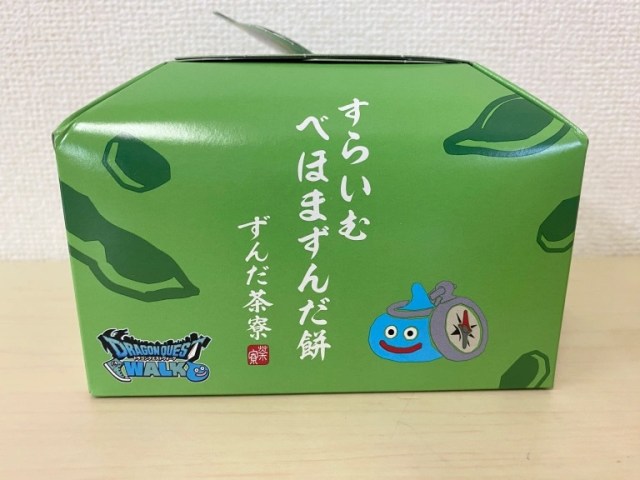
Sweet edamame Slimes draw near to our stomachs as Dragon Quest teams up with maker of northeastern Japan’s most famous traditional dessert,
In most countries, “Hey, this food looks like slime!” wouldn’t exactly be a selling point for a confectioner. In Japan, though, where the Dragon Quest video game franchise is a pop culture institution, a resemblance between your desserts and capital-S Slimes, the series’ mascot monsters, can out smiles on faces and growling in stomachs.
And so it is that Kasho Sanzen, a Japanese sweets maker in the city of Sendai that’s been around since 1947, is selling boxes of sweet Slime dumplings.
Called the Slime Behoma Zunda Mochi, the set consists of eight of the traditional sweets called zunda mochi, the representative dessert of Sendai and the surrounding Miyagi Prefecture. Why eight? Because in Dragon Quest, when eight Slimes get together they can combine to form a King Slime, which is the species depicted on the front of the box.
Meanwhile, around the side…
…is a Slime version of Date Masamune, the local samurai lord known as the One-Eyed Dragon whose battlefield attire included an eyepatch and distinct crescent-ornamented helmet.
Opening up the box reveals the individual Slimes/mochi cakes. A total of four illustrations are featured on the wrappers, representing different slime variants. You might also notice a colorful “S” in the upper left corner.
This isn’t short for “Slime,” though, but a reference to S designating a high level of rarity or power in Japanese video games. These zunda mochi Slimes are part of a tie-up between Kasho Senzan and GPS-based mobile game Dragon Quest Walk, and the sweets are available as a possible prize for completion of in-game quests in the Sendai area or for purchase through Kasho Senzan’s online shop (which is how we got ours).
Zunda mochi gets its green color from the use of edamame soybeans, which are mashed into a paste which is then used to cover a mochi rice cake at the center. Even in their normal form, zunda mochi’s soft texture and semi-spherical shape makes them look like Slimes, but we’re pretty sure Kasho Senzan has gone the extra mile with these ones by giving them a pointy tip that makes the resemblance even stronger. As a matter of fact, we felt just a twinge of guilt biting into them, but like a Level 1 hero who needs to fight Slimes to gain experience and level up, we hardened our hearts and bit into one.
The inside is even more vibrantly verdant, and the flavor is both delicious and sophisticated. Compared to Japanese desserts made with azuki (sweet red beans), zunda mochi has an earthier, more bean-like flavor. It’s often described by foodies in Japan as having a moyamoya flavor, meaning “hazy” or “indistinct,” because of how it straddles sweet, salty, and bitter flavors. There’s really nothing else quite like it, and if the combination of tastes works for you, you’ll probably be reaching for a second zunda Slime as soon as you finish your first.
You might want to pace yourself, though, because the Slime Behoma Zunda Mochi isn’t easy to come by. Each day a new batch goes on sale on the Kasho Senzan online store at 10 a.m. and they often sell out in less than five minutes. It took us several days of trying before we managed to get ours, but it was worth the trouble, and since they’ll be on sale until May 31, you’ve still got plenty of chances to get some for yourself. The set is priced at 1,480 yen (US$11.30) and can be ordered here, and while you’re at it, don’t forget that Kasho Senzan has another must-eat Sendai sweet too.
Photos ©SoraNews24
● Want to hear about SoraNews24’s latest articles as soon as they’re published? Follow us on Facebook and Twitter!
[ Read in Japanese ]
Follow Casey on Twitter, where he still regrets not buying the cub at the start of the first Dragon Quest.
[ Read in Japanese ]

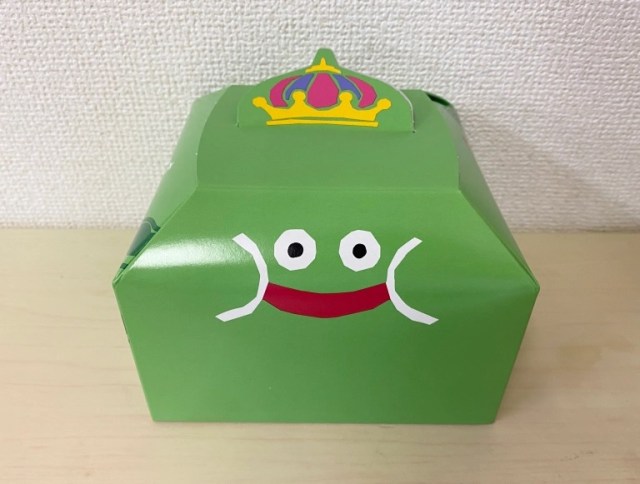
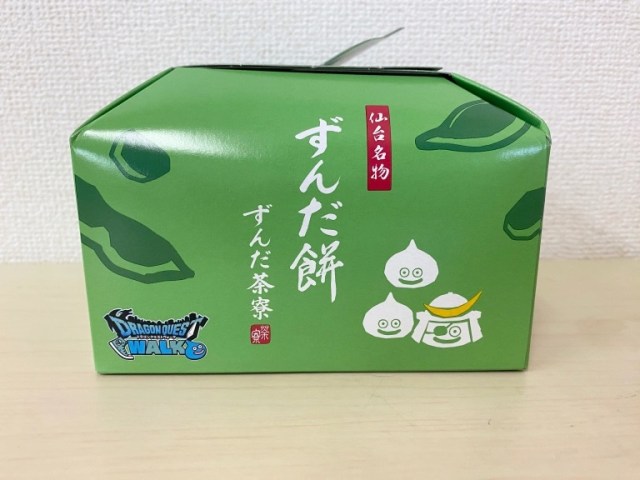
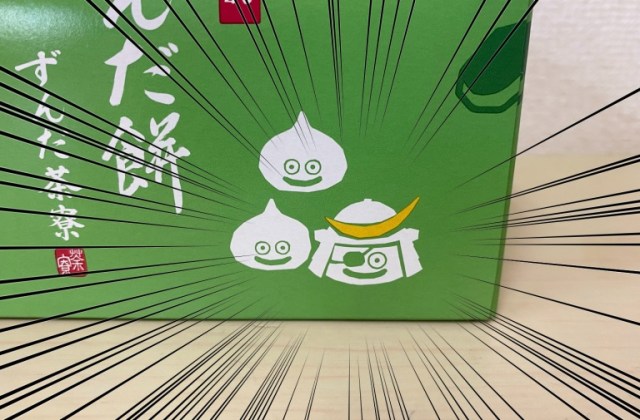
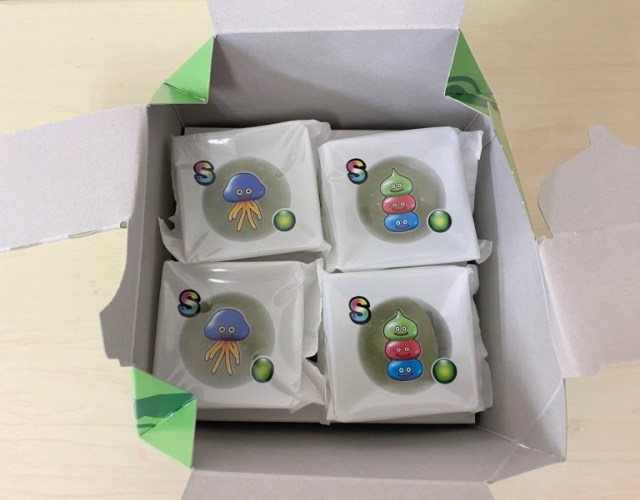
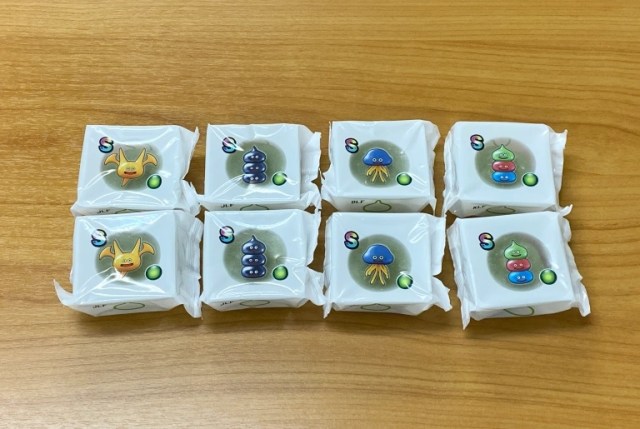
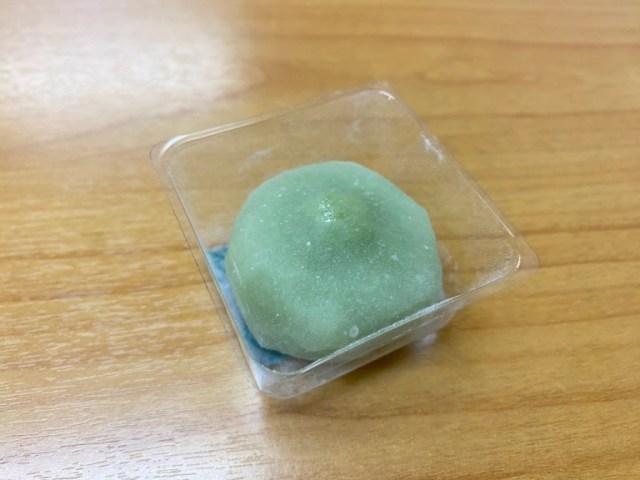
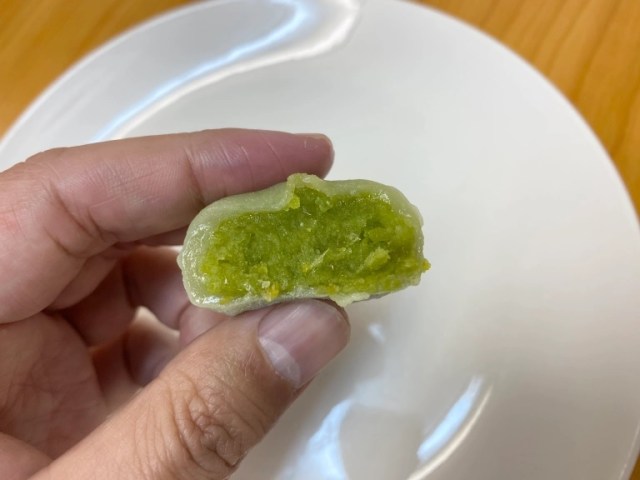
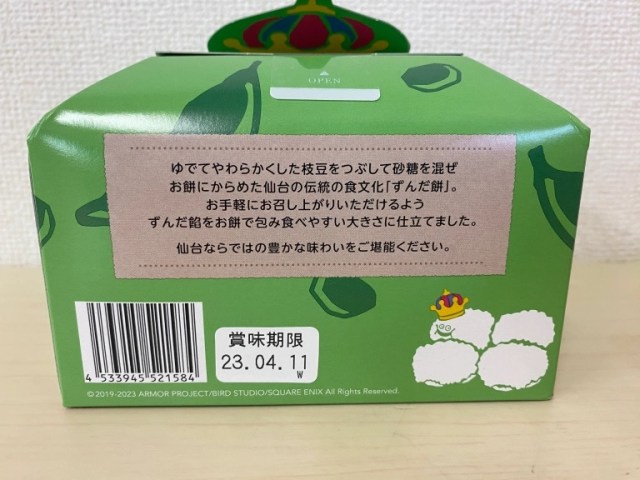
 Japanese KitKats now come in edamame milkshake flavour
Japanese KitKats now come in edamame milkshake flavour Häagen-Dazs new zunda mochi ice cream gives us a lot of delicious things to think about
Häagen-Dazs new zunda mochi ice cream gives us a lot of delicious things to think about Japan’s new old-school Dragon Quest sweets are Slime-like in more ways than one【Taste test】
Japan’s new old-school Dragon Quest sweets are Slime-like in more ways than one【Taste test】 Slime bread arrives in Japanese convenience stores and in our Dragon Quest-loving bellies
Slime bread arrives in Japanese convenience stores and in our Dragon Quest-loving bellies Japan’s Slime ice cream will Heal you since it’s a Dragon Quest tie-up with Baskin-Robbins Japan
Japan’s Slime ice cream will Heal you since it’s a Dragon Quest tie-up with Baskin-Robbins Japan Japan’s new difficult-to-drink-from beer glass protects your liver, but it’s a brutal experience
Japan’s new difficult-to-drink-from beer glass protects your liver, but it’s a brutal experience Demon Slayer: Kimetsu no Yaiba gets new roller coaster attractions and food at Universal Studios Japan
Demon Slayer: Kimetsu no Yaiba gets new roller coaster attractions and food at Universal Studios Japan How to order snacks on a Shinkansen bullet train in Japan
How to order snacks on a Shinkansen bullet train in Japan Come play hide-and-seek on a deserted Japanese island this August and November
Come play hide-and-seek on a deserted Japanese island this August and November New Pokémon ice cream, dessert drinks, and cool merch coming to Baskin-Robbins Japan【Pics】
New Pokémon ice cream, dessert drinks, and cool merch coming to Baskin-Robbins Japan【Pics】 Princesses, fruits, and blacksmiths: Study reveals the 30 most unusual family names in Japan
Princesses, fruits, and blacksmiths: Study reveals the 30 most unusual family names in Japan Turns out you can draw all four original starter Pokémon with just three colored pencils【Video】
Turns out you can draw all four original starter Pokémon with just three colored pencils【Video】 W.T.F. Japan: Top 5 craziest Japanese certification exams 【Weird Top Five】
W.T.F. Japan: Top 5 craziest Japanese certification exams 【Weird Top Five】 High-fashion Totoro cuddle purse is like an elegant stroll in the forest【Photos】
High-fashion Totoro cuddle purse is like an elegant stroll in the forest【Photos】 Live-action Spirited Away stage play is finally available for on-demand streaming
Live-action Spirited Away stage play is finally available for on-demand streaming Nintendo history you can feel – Super NES, N64, and GameCube controllers become capsule toys
Nintendo history you can feel – Super NES, N64, and GameCube controllers become capsule toys Hello, cosmetics! Clinique teams up with Hello Kitty this summer for first-time collaboration
Hello, cosmetics! Clinique teams up with Hello Kitty this summer for first-time collaboration “The most Delicious Cup Noodle in history” – Japan’s French Cup Noodle wins our heart【Taste test】
“The most Delicious Cup Noodle in history” – Japan’s French Cup Noodle wins our heart【Taste test】 Starbucks releases a cute Frappuccino and Unicorn Cake…but not in Japan
Starbucks releases a cute Frappuccino and Unicorn Cake…but not in Japan Kyoto Tower mascot termination reveals dark side behind cute Japanese characters
Kyoto Tower mascot termination reveals dark side behind cute Japanese characters McDonald’s Japan’s Soft Twist Tower: A phantom ice cream only sold at select branches
McDonald’s Japan’s Soft Twist Tower: A phantom ice cream only sold at select branches Yabai Ramen: What makes this Japanese ramen so dangerous?
Yabai Ramen: What makes this Japanese ramen so dangerous? Finally! Nintendo Japan expands Switch 8-bit controller sales to everybody, Online member or not
Finally! Nintendo Japan expands Switch 8-bit controller sales to everybody, Online member or not Japanese government wants to build luxury resorts in all national parks for foreign tourists
Japanese government wants to build luxury resorts in all national parks for foreign tourists To combat declining birth rate, Japan to begin offering “Breeding Visas” to foreigners
To combat declining birth rate, Japan to begin offering “Breeding Visas” to foreigners 10 things you should buy at 7-Eleven in Japan
10 things you should buy at 7-Eleven in Japan Studio Ghibli releases anime heroine cosplay dresses that are super comfy to wear
Studio Ghibli releases anime heroine cosplay dresses that are super comfy to wear Woman charged for driving suitcase without a license in Osaka
Woman charged for driving suitcase without a license in Osaka Studio Ghibli unveils My Neighbour Totoro miniature house model
Studio Ghibli unveils My Neighbour Totoro miniature house model Kyoto experiencing problems with foreign tourists not paying for bus fares, but not on purpose
Kyoto experiencing problems with foreign tourists not paying for bus fares, but not on purpose Fighting mild hunger with a Japanese soda that turns into jelly in the stomach【Taste test】
Fighting mild hunger with a Japanese soda that turns into jelly in the stomach【Taste test】 Studio Ghibli’s Howl’s Moving Castle tapestry unveiled in Japan for first time
Studio Ghibli’s Howl’s Moving Castle tapestry unveiled in Japan for first time McDonald’s new Happy Meals offer up cute and practical Sanrio lifestyle goods
McDonald’s new Happy Meals offer up cute and practical Sanrio lifestyle goods Sales of Japan’s most convenient train ticket/shopping payment cards suspended indefinitely
Sales of Japan’s most convenient train ticket/shopping payment cards suspended indefinitely Sold-out Studio Ghibli desktop humidifiers are back so Totoro can help you through the dry season
Sold-out Studio Ghibli desktop humidifiers are back so Totoro can help you through the dry season Japanese government to make first change to romanization spelling rules since the 1950s
Japanese government to make first change to romanization spelling rules since the 1950s Foreigner’s request for help in Tokyo makes us sad for the state of society
Foreigner’s request for help in Tokyo makes us sad for the state of society Ghibli founders Toshio Suzuki and Hayao Miyazaki contribute to Japanese whisky Totoro label design
Ghibli founders Toshio Suzuki and Hayao Miyazaki contribute to Japanese whisky Totoro label design Doraemon found buried at sea as scene from 1993 anime becomes real life【Photos】
Doraemon found buried at sea as scene from 1993 anime becomes real life【Photos】 Tokyo’s most famous Starbucks is closed
Tokyo’s most famous Starbucks is closed Dragon Quest town and adventure RPG attraction coming to Japanese theme park
Dragon Quest town and adventure RPG attraction coming to Japanese theme park Best random JRPG encounter ever? When giant 3-D Dragon Quest Slimes appear in Tokyo!【Video】
Best random JRPG encounter ever? When giant 3-D Dragon Quest Slimes appear in Tokyo!【Video】 Giant, paint-your-own Slimes appear as part of Dragon Quest public art event this summer in Yokohama
Giant, paint-your-own Slimes appear as part of Dragon Quest public art event this summer in Yokohama We munch on some real-life Slime dumplings from the Dragon Quest Walk collaboration
We munch on some real-life Slime dumplings from the Dragon Quest Walk collaboration Increase your EXP with this Dragon Warrior-inspired Slime Curry, don’t forget the Squelch spell
Increase your EXP with this Dragon Warrior-inspired Slime Curry, don’t forget the Squelch spell Special slime kiosk at Shinjuku Station is ready to give your phone all the HP it needs
Special slime kiosk at Shinjuku Station is ready to give your phone all the HP it needs Fit’s gum collaborating with Slime for Dragon Quest’s 30th anniversary
Fit’s gum collaborating with Slime for Dragon Quest’s 30th anniversary Dragon Quest Heal magic-flavored fried chicken coming to Japan to keep video game fans’ HP full
Dragon Quest Heal magic-flavored fried chicken coming to Japan to keep video game fans’ HP full Dragon Quest Super Light Cafe draws near! Command?
Dragon Quest Super Light Cafe draws near! Command? We sample blue Drift Ice Curry from the India of the Okhotsk Sea
We sample blue Drift Ice Curry from the India of the Okhotsk Sea Newsflash: Silver “Dragon Quest Metal Slime Edition” PlayStation 4 unveiled by Sony 【Updated】
Newsflash: Silver “Dragon Quest Metal Slime Edition” PlayStation 4 unveiled by Sony 【Updated】 New Dragon Quest legendary baby armor turns your child into the hero of life’s adventures
New Dragon Quest legendary baby armor turns your child into the hero of life’s adventures Gigantic real-life Dragon Quest video game slime to appear in Japan this Christmas
Gigantic real-life Dragon Quest video game slime to appear in Japan this Christmas Sweet mochi beer? Yamanashi sweets maker teams up with craft brewer for Kuromitsu Black
Sweet mochi beer? Yamanashi sweets maker teams up with craft brewer for Kuromitsu Black Move over itasha, here come itachoko – anime chocolates!
Move over itasha, here come itachoko – anime chocolates! Japan turns the confectionery world on its head with stretchy mochi-covered chocolates
Japan turns the confectionery world on its head with stretchy mochi-covered chocolates Demon Slayer Nichiren Blades ready for new duty: Slicing through your sweets as dessert knives
Demon Slayer Nichiren Blades ready for new duty: Slicing through your sweets as dessert knives
Leave a Reply